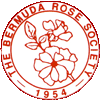Smith’s Parish Rose: A Bermuda Mystery
By Charles A. Walker, Jr.
In 1984, I had the honour of judging the roses in Bermuda’s Agriculture Exhibition and at The Bermuda Rose Society’s Show. During this most enjoyable visit, one of the Island’s repeat-blooming “Mystery” Roses considerably piqued my curiosity. Not yet identified, this rose has been giving the local name of “Smith’s Parish,” denoting the area where it was found. Its red-tinged buds open to fairly double creamy white blooms. The irregularly-shaped inner petals are initially blushed with faint pink at their edges, which have a somewhat tattered aspect. Some of its blooms are vividly striped in varying degrees with red. More rarely, an entire bloom will be red, pink, or perhaps a combination of the two. Peggy Wingood’s excellent photo, showing various colour possibilities, appears in Old Garden Roses in Bermuda, 1984, and is reproduced in this issue of The Rose. Blooms are cupped, becoming flat, with deep red styles contrasting strongly with the white petals and golden stamens. The leaves and smooth wood are rather lighter green than that of most roses. Prickles on basal canes are yellowish-orange near the base, shading to greenish yellow near the apex. The readily produced hips are rounded and become orange-yellow at maturity. “Smith’s Parish” is probably best described as a China-Tea.
While puzzling over the identity of this rose, I reviewed some notes gleaned from earlier studies of multi-coloured roses. The most promising possibility came from History of European Botanical Discoveries in China by Dr. Emilio Bretschneider, 1898. Therein is mentioned ‘Five-coloured Rose,’ a China discovered by Robert Fortune in a Ning Po garden in 1844 and described as producing blooms of either red or French-white, sometimes striped with both colours. Bretschneider referred to an illustration in Flores des Serres, 1898, and a trip to nearby Duke University’s Perkins Library afforded me a look at this plate. The Tea rose it depicts has a tight bud, showing both white and dark red, as well as a nodding, rather loosely formed, yellowish-white bloom striped on several of its crinkled petals with a light red or pink. The edges of many of the inner petals are washed with light pink and notched. Unfortunately, the moderately full bloom does not reveal its styles and neither basal cane prickles nor hips are pictured.
The accompanying text, written by Louis Can Houtte, was translated with the kind of assistance of Janine Breitenberger. Van Houtte noted that the rose (for which he paid five pounds sterling!) has two colours rather than five, most petals bearing a stripe or band of vivid crimson. According to him, this was the only striped Tea rose. Leaves were described as light green and trifoliate. However, the plate shows rather dark green foliage and at least two leaves with five leaflets. In addition, leaf serration is exaggerated, stems are crudely ornamented with far more prickles than are typical of Teas or Chinas, and sepals appear excessively foliated. Since plates of familiar roses elsewhere in this periodical are depicted inaccurately in certain details, we can assume that comparable artistic liberty has been taken with this place as well.
Another bit of information comes from a Mr. Cadness of the U.S Firm of Parson & Co. of Flushing, New York, which imported ‘Five-coloured Rose’ from England about 1850. Writing in 1851, he noted that the rose set seed freely, a point which compares quite favourably with the behaviour of “Smith’s Parish.” Both Van Houtte and Cadness had grown the rose for only a year or so prior to writing about it and we must take this into consideration, since typical growth and blooms for some roses may not be seen for several years, depending on cultural conditions. On balance, however, the evidence accumulated to date does suggest that “Smith’s Parish” is ‘Fortune’s Five-coloured Rose.’ Perhaps further study of the literature and of the rose will provide a definite answer.
Depite its unique striping, ‘Five-colourd Rose’ seems to have been quite rare and it has, apparently, vanished from European and American gardens. However, given Richard Thompson’s re-discovery of ‘Slater’s Crimson China’ in 1953, the presence of another long-lost rose in Bermuda is perhaps to b expected. The Bermuda Rose Society has played no small part in preserving these living museum pieces. We commend these dedicated rosarians for 30 years of intense interest and untiring efforts of Old Garden Roses.
Note: A rose labelled ‘Fortune’s Five-coloured Rose’ has been seen growing in the Descanso Gardens, La Canada, California. It seems to be identical to “Smith’s Parish” except that it has a green eye. So the “mystery” continues. Dr. Walker, writing in the January 1994 Heritage Rose Foundation News emphasises that “Smith’s Parish” has not been proven to be ‘Five-coloured Rose’ and questions how appropriate it as such.
“The name “Smith’s Parish” has served this fascinating Bermudian “Mystery” rose very well for quite a long time-and without confusion. I can see no reason to discard it now in favour of another name which, despite its appeal as belonging to a long-lost rose, cannot be proven.”

